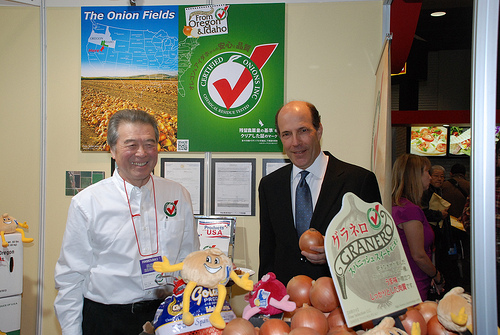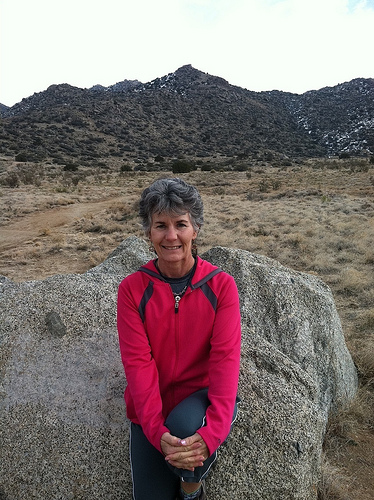Helping U.S. exporters tap into Japan’s $670 billion food market is a top priority for the Foreign Agricultural Service’s Agricultural Trade Office (ATO) in Japan. One way we do this is by organizing the USA Pavilion at FOODEX Japan, the largest food and beverage trade show in Asia. This year’s show, which was held March 6-9, drew 74,000-plus attendees, not just from Japan but also from other Asian markets including Korea, Taiwan, China, Thailand and Hong Kong.

U.S. Ambassador to Japan John V. Roos (right) visits a U.S. organic onion exhibit at the USDA-endorsed FOODEX Japan. The food and beverage show took place March 6-9 and is the largest show of its kind in Asia. The U.S. Pavilion was one of the largest at the show and featured more than 70 companies. (Photo Courtesy of the U.S. Embassy in Tokyo)
The USA Pavilion was one of the largest at the show, featuring more than 70 U.S. companies and a wide range of “Made in America” products, including meat and seafood, fresh produce, wine and specialty snack foods. Participants had an opportunity to showcase their wares to key decision-makers from restaurants, supermarkets, wholesalers, grocery stores, foodservice and hospitality companies, fast food chains and convenience stores, as well as distributors, agents and brokers. Read more »
This post is part of the Science Tuesday feature series on the USDA blog. Check back each week as we showcase stories and news from the USDA’s rich science and research portfolio.
As part of the U.S. government’s global hunger and food security initiative called Feed the Future, USDA is building collaborative scientific partnerships with nearly a dozen organizations that will help U.S. and African goat producers enhance goat breeding and productivity.
Feed the Future is part of a multilateral effort launched at the L’Aquila World Summit on Food Security in 2009 to accelerate progress toward the Millennium Development Goal of halving the proportion of people living in extreme poverty and suffering from hunger by 2015. The program enables affected governments and their people to take the lead in developing and implementing food security solutions. These “country-driven” strategies give ownership and accountability, while tackling the root causes of hunger and poverty. Working with the U.S. Agency for International Development (USAID), USDA offers strong competencies in capacity development, food assistance, research and technology transfer in support of Feed the Future. Read more »

Bequi Livingston, Smokey Bear Hotshot Crew, U.S. Forest Service
When she was in high school, Bequi Livingston read a book about firefighting and was quickly intrigued. Little did she know that she would one day become one of the U.S. Forest Service’s pioneer women in wildland firefighting and fight fires for nearly 20 years.
After graduating from college, an article in her local newspaper caught her eye. The article was about the Young Adult Conservation Corps encouraging people to apply for its fire crew on the Smokey Ranger District. Livingston was accepted, but when she excitedly reported to work on her first day on the Lincoln National Forest, her office manager was surprised to meet a woman. Read more »
The Biomass Crop Assistance Program, or BCAP, is still in its infancy, but its potential success has producers and businesses wanting more.
“We have people on a waiting list,” said Tim Wooldridge, Arkansas project manager with MFA Oil Biomass. MFA was selected by USDA to manage three of nine project areas in fiscal year 2011. Each project area was awarded federal funding to provide incentives to farmers to grow non-food crops that can be processed into biofuels. “Our initial target in the Arkansas project was 5,000 acres, which we surpassed in signing up 6,588 acres. We now have 1,500 acres on a waitlist. We could easily get another 6,000.” Read more »
Cross posted from the White House Council on Environmental Quality blog:
I was recently in Atlanta, Georgia to speak at the North American Wildlife and Natural Resources Conference about Working Lands for Wildlife, a new effort to focus both conservation dollars and wildlife management expertise on the recovery of seven at-risk, threatened or endangered wildlife species. This unique approach to conservation concentrates federal resources on private working lands—home to a majority of candidate and listed species under the Endangered Species Act. Working Lands for Wildlife was developed by the Department of Agriculture and the Department of the Interior through their membership in the White House Rural Council.
Working with farmers, ranchers and forest landowners is critical to President Obama’s vision of an economy built to last, one where rural communities provide clean air, clean water and wildlife habitat to generate economic opportunities for outdoor recreation and jobs, while protecting farm and ranch traditions. Working Lands for Wildlife demonstrates the President’s focus on the rural economy and his commitment to keep working lands working. Read more »
It’s been a little over two weeks since we launched the Know Your Farmer, Know Your Food Compass, which includes a multi-media PDF narrative and an accompanying interactive map. Together, they’re designed to help you navigate USDA’s grant and loan programs and learn how USDA supports the development of local and regional food systems. You’ll hear about people across the country putting these resources to work. We hope you’ll be inspired and perhaps get some new ideas to try out on your farm or ranch or in your community.
We never intended to launch the KYF Compass and call it a day. This is just the beginning of what we hope will be a long-term conversation about new opportunities in local and regional food. We’ve reached out to you through a webinar, over Twitter, in our blog and in events with stakeholders to hear your feedback and ideas. And you’ve certainly kept up your end of the conversation! Read more »


